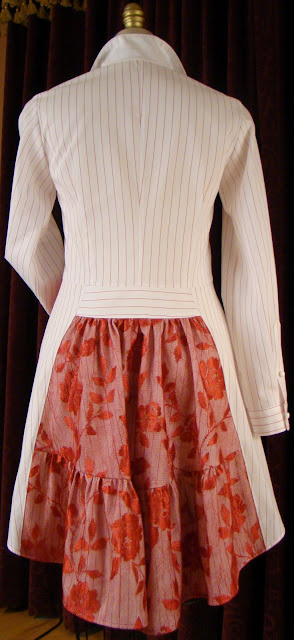Sometimes a sewing project should be easy and creative. Start with a basic T-shirt pattern: a front cut on a fold, a back cut on a fold, and an optional sleeve. I used pattern #104 from pamelaspatterns.com, but feel free to use any patten you think will fit well.
 If you want a very fitted T-shirt, choose one size smaller than your bust measurement. Use cotton/spandex for a firm, fitted look.
If you want a very fitted T-shirt, choose one size smaller than your bust measurement. Use cotton/spandex for a firm, fitted look.For these sample garments I am using rayon/spandex knits that drape and change shape easily. They do not hold a firm shape so I chose the pattern size that would cut a garment one inch larger than my bust measurement.
The first sample is a khaki rayon/spandex knit. The garment is plain but definitely useful in a wardrobe.
The second sample is the same pattern in a more interesting fabric: metallic gray/silver rayon/spandex knit. The metallic knit top might overpower a casual outfit if I over embellish, so I'll just add a center back panel that is longer and narrow than the pattern back piece. The extra length will allow the back to blouson and move away from the body.
This is the same knit used in the 1936 vintage halter dress posted on 5/3/12.
The back panel was sewn to the garment back at the neck and shoulders, then the two layers are caught in the shoulder seams and neck binding. The back panel was twisted six times and then joined to the tee at the hem. A simple technique and the garment becomes interesting yet still wearable. I'd love to see the panel cut in chiffon and added to the back of a dress.
The third sample is a red bamboo/spandex knit. Note how the armholes and back shoulder seam allowances have 1/2" fusible interfacing applied in the seam allowance on the wrong sides. I interface all knit garments in this manner. The interfacing controls the size and stretch of the armholes and shoulder seams. The neckline seam allowance is not interfaced because a neckband will control the neckline shape.

A second front panel is cut with a V neckline and angled front hem. The neck and hem of this layer will be left as raw cut edges. The shoulders, armholes and side seams will be joined in to the garment seams.
I have slashed the second front panel with a rotary cutter against a ruler. The slashes are 1" apart. Choose any pattern for your slash marks. You don't know what the result will be, so you are taking a risk here. Horizontal rows down center front would be an attractive alternative.
The finished garment is fun to wear and so fast to sew. I would try this cutting technique on the back panel of the silver tee above for fun. The possibilities are endless and this is a quick way to decrease the size of your fabric stash!























